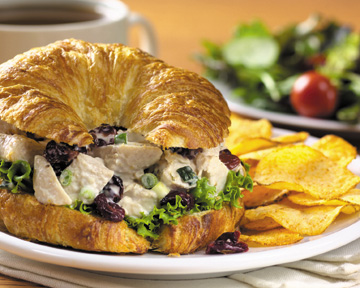Failures in food hygiene are presented commonly. I experienced this while picking up my lunch recently in Springfield, Missouri. This quaint bar and grill near Sequiota Park presented me with the decision to eat it or not.
The chicken salad sandwich was excellent but watching the preparation was not excellent. The chicken salad mix was covered but sat on the prep counter at room temperature. The owner, I assume, spooned the salad mix onto a croissant that he had just bare handedly cut and separated into two halves. He  patted the two halves back together when finished and he pushed the spewing excess back into the seams. He set the creation into a to-go box, piled a few potato chips on top (again bare handed), and got a pickle from somewhere (it wasn’t from a jar). He served it with a kind-of-a-smile that I hope does not cost me in the future.
patted the two halves back together when finished and he pushed the spewing excess back into the seams. He set the creation into a to-go box, piled a few potato chips on top (again bare handed), and got a pickle from somewhere (it wasn’t from a jar). He served it with a kind-of-a-smile that I hope does not cost me in the future.
Breaks in food hygiene protocol can cause significant discomfort to a large number of patrons. Bare hands and improperly-kept utensils can transfer foodborne-illness-causing bacteria to the prepared food or from potentially hazardous foods to ready-to-eat items. When a food preparer handles money, works the cash register, or touches the face or body while wearing gloves, the potential for contamination of ready-to-eat foods is also high.
A simple breech in food hygiene is not so simple to correct. The process of food safety is complicated and there is a constant vigilance required to prevent or mitigate foodborne illness.
